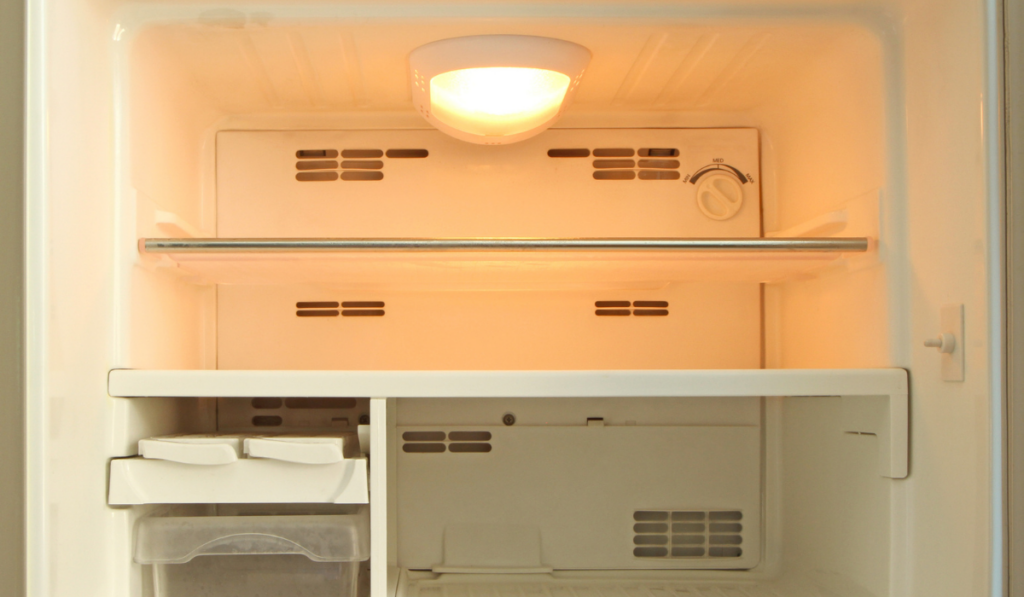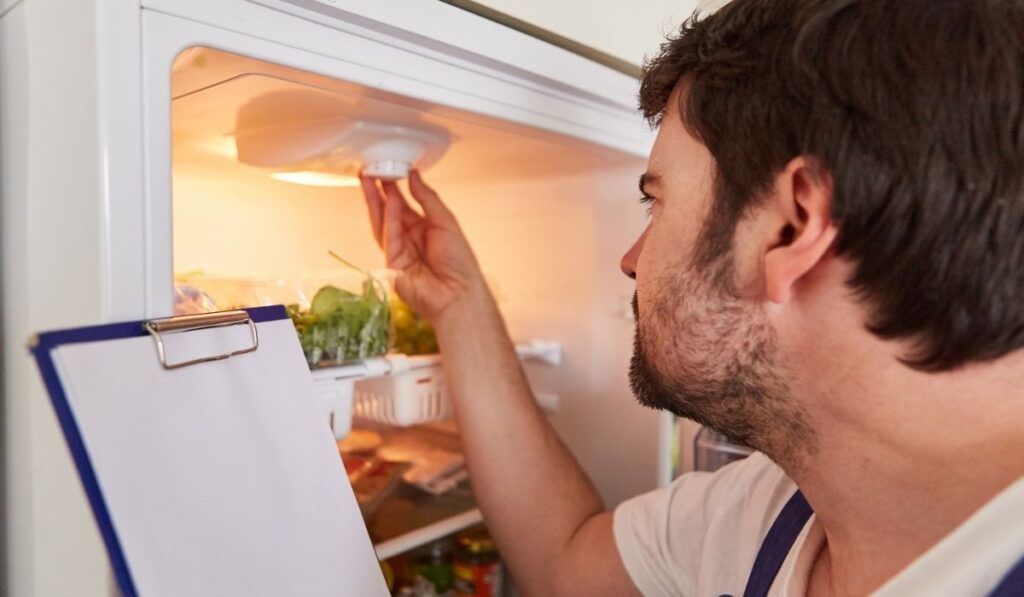When was the last time the lightbulb in your refrigerator went off? You probably cannot remember because it always seems to be on. But what happens when the bulb is off and needs replacement? What kind of bulb are you supposed to use? Do you have to unplug your fridge to change the light bulb?
While regular light bulbs can be used in a refrigerator, it’s not recommended. It’s best to use appliance bulbs in a fridge because they are durable and minimize the risk of exploding. They are also customized to withstand extreme temperatures and conditions in appliances.
By the end of this post, you will know what kind of light bulbs go into a refrigerator, the difference between an appliance bulb and a regular bulb, and whether you can use a standard bulb in a refrigerator. We will also dive into the frequently asked questions, including whether a fridge can still work without a bulb. So let’s dive right in!
What Kind of Lightbulb Goes in a Refrigerator?

While you can still use a regular bulb, it’s best to go for an appliance bulb in your refrigerator because they last longer and have a lower risk of exploding.
Unlike other appliances such as your oven or dryer, the fridge has a broader range of light bulb wattages. They come in wattages from 25 to 40 for standard base appliance bulbs, while other home appliances use between 10 and 25 watts on average.
What Is the Difference Between an Appliance Bulb and a Regular Bulb?
The main difference between appliance bulbs and regular bulbs is in their specifications, so before replacing appliance bulbs, read the equipment manual thoroughly.
Other differences include:
Durability
These bulbs are also designed to withstand extreme temperatures and conditions in high-consuming electrical appliances. It thrives in warm places like an electric stove or the light inside your oven or freezer, able to withstand long periods in harsh environments.
Appliance bulbs are built to last, whereas regular bulbs cannot withstand impact. They have a thicker filament that can withstand vibrations and are also shatterproof.
Construction
Appliance light bulbs have slightly thicker glass than regular bulbs, and the filament is mounted more securely. And they are smaller than regular bulbs, typically A19 in size. So a larger bulb may be too big to fit suitably in a fridge.
But appliance bulbs are more expensive than regular bulbs due to their tougher construction. So make sure you consider this fact before choosing hot appliances like ovens.
Lifespan and Energy Usage
Since LED light bulbs do not use a filament to produce light, they use less energy. But regular bulbs use a lot of energy because filaments consume more power than the light they make. And the brightness of LED light bulbs is significantly higher than traditional light bulbs.
Appliance bulbs are also long-lasting, with a lifespan of about 50,000 hours. On the other hand, regular bulbs only have about 1,000 hours.
Since appliance and regular bulbs have the same base, you should not mix them up. For instance, a typical LED bulb with a standard E26 base will fit in an oven but melt almost immediately.
You should also note that the environment, energy consumption, and brightness level are all impacted differently by both LED and regular light bulbs. And, even though appliance bulbs are more expensive than standard bulbs, they are highly recommended as they are environmentally friendly.
Can You Use a Regular Light Bulb in a Refrigerator?
Yes, you can use a regular light bulb in a refrigerator.
However, even though a standard bulb may work in a fridge, we do not recommend it. This is because regular light bulbs are easily breakable and cannot withstand extreme temperatures.
What Are the Main Types of Refrigerator Light Bulbs?
For you to effectively understand the types of lightbulbs used in your refrigerators, we have compiled a list of bulbs below:
LED (Light-Emitting Diode) Bulbs
LED bulbs are broad-spectrum light bulbs that can be used for different purposes while emitting various colors.
These bulbs are highly durable and energy-efficient. They produce no heat but still emit bright light. The best part is that they do not have a warm-up period but turn to their full potential right away.
Incandescent Light Bulb
The incandescent light bulb is the most common and least expensive bulb type. These bulbs emit a warm glow and last for up to a year.
They are, however, inefficient in terms of energy consumption. Their actual light is created with less than 5% of the energy produced. Incandescent also produce heat but waste about 95% of the energy they consume. This is why incubators and heat lamps benefit significantly from this bulb type.
Halogen Light Bulbs
Although halogen bulbs are energy efficient, they heat up quickly. If you touch a halogen bulb with your hands, the oil from your skin can cause it to explode because of the heat it emits.
Halogen bulbs are the least durable types of bulbs and emit white light. They are primarily used for fixed lighting, such as floodlights or stage lighting in theaters.
CFL (Compact Fluorescent Lighting) Bulbs
Warming up CFL bulbs takes time, and the longer they are on, the brighter they become.
These bulbs were designed to replace incandescent bulbs due to their energy efficiency and durability. They are low-energy and can emit various colors depending on your preferences.
Will It Make a Difference Which Light Bulb I Use?
When it comes to the amount of light produced, the bulb you use makes no difference. What matters is the wattage used.
Watts is the unit of measurement for the amount of energy required to provide light, while the brightness of the light is measured in lumens. So, when choosing a light bulb, ensure the wattage matches the recommended wattage for your circuit.
Should You Use Regular Bulbs in Any Appliance?
Replacing your current bulb with an ordinary bulb is not an option for appliances such as ovens and microwaves. You can use a regular bulb with refrigerators, but it is best not to.
When in doubt, read your appliance’s handbook and thoroughly go through the specifications of any light bulb you may be considering.
How Long Do Refrigerator Light Bulbs Last?
When it comes to lifespan, the LED bulb can survive up to 15,000 hours of continuous use, which is a lot of refrigerator door opens and closings.
Aside from the limited daily usage period, another factor contributing to the refrigerator light bulb durability is that appliance bulbs are not manufactured for 1000 hours like conventional A-19 bulbs but rather for longer life. For example, the rated life of a 40W A-15 clear incandescent bulb is 1750 hours, not 1000 hours.

1. Can a Fridge Still Work Without a Light?
If your fridge is cooling as usual but is dark, then it means that the light bulb is faulty, and this has nothing to do with the internal functioning of the refrigerator. So, you should only troubleshoot the fridge if necessary.
Once you confirm that the light is not working, you can:
Change the Bulb
Remove the bulb and replace it with a new one. You can quickly tell that the bulb is worn out if you hear some broken filaments moving around upon shaking it.
Assess the Light Bulb Socket in the Refrigerator
Make sure the light bulb socket is in optimal working condition. First, look for discolored or bent terminals, damaged wires, wires that aren’t connected, a cracked light socket, or a light socket that has been damaged by heat over time.
These are issues that impact the connection between the socket and the bulb causing it not to light up.
Before inspecting or checking a light socket in your refrigerator, remember to turn off the power because it still has voltage even if it isn’t working correctly.
Ensure the Refrigerator Door Switch is in Good Working Order
A refrigerator door switch allows voltage to flow to the light bulb when you open the fridge door. If you still have no light after replacing the bulb and the light socket appears to be in good working condition, you should check the fridge door switch.
The door switch is located somewhere on the interior edge of your refrigerator, depending on the model. Please remove the door switch with care and use a meter to check for continuity.
2. Do I Have to Unplug My Fridge to Change the Light Bulb?
Yes. It’s best to unplug your fridge to change the light bulb for your safety and protect the light circuit.
Here’s a quick step-by-step guide on how to change a light bulb in the refrigerator.
- First, remove the fridge plug from the electrical socket to stop the power supply.
- Press the hooks on both sides of the light cover top to remove the bulb.
- Replace the old light bulb with a new one that should preferably use no more than 15 watts.
- Change the light exterior and wait for about 5 minutes before plugging in the unit.
3. What Kind of Lightbulb Goes in a Frigidaire Refrigerator?
The best bulbs for a frigidaire refrigerator are incandescent, 5304440031 Frigidaire 20-Watt Appliance Light Bulbs. These appliance bulbs are customized with heavy-duty filaments for a long lifespan and can be used in other household appliances, including ovens and microwaves.
Most frigidaire refrigerators use a 25- to 40-watt standard base appliance bulb, but some use a T8 intermediate base bulb.
